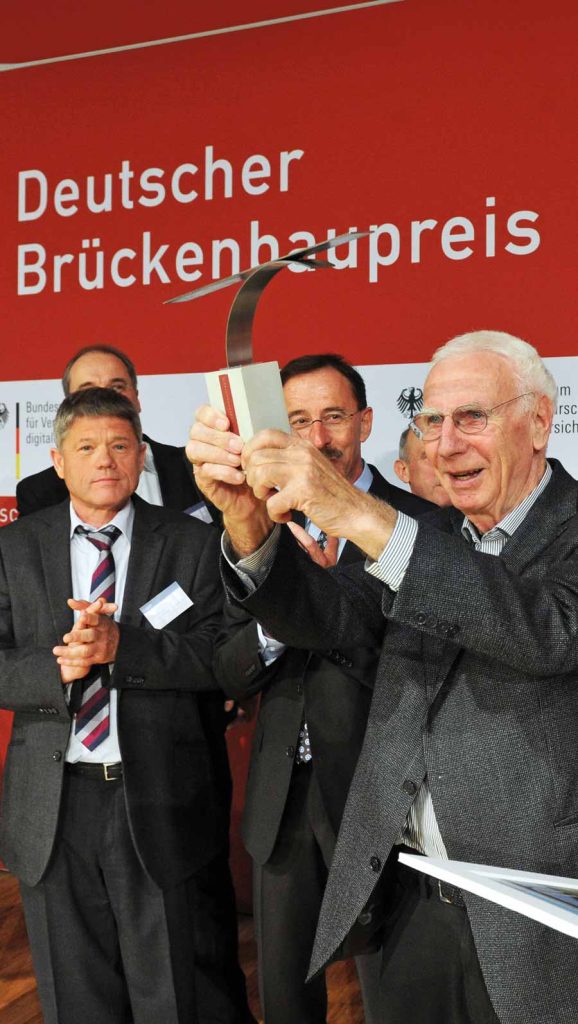Personal Awards
Großer DAI Preis für Baukultur 2012
Premio José Entrecanales Ibarra a la Ingeniería Civil 2008
The Japan Structural Design Award 2006, Japan Structural Designers Club, Tokyo
Eduardo Torroja Medal, IASS, 2004
Werner von Siemens Ring, 2002
Fritz Leonhardt Award, 2002
Emil Mörsch memorial medal, German Concrete and Construction Technology Association, 1995
Prix Albert Caquot, French Association of Civil Engineering, 1999
Swedish Concrete Award 1995
Fritz Schumacher Prize 1992
IABSE Award of Merit in Structural Engineering 1991
Gold Medal of the Institution of Structural Engineers, London, 1990
FIP Freyssinet Medal (Fédération Internationale de la Précontraite) 1990
Project Awards
„German Steel Construction Award“ 2017, category bridge construction for EÜ Allerbrücke Verden
German Bridge Construction Award 2008, category road and railroad bridges for Humboldthafen Bridge at Berlin Central Station
Zumtobel Group Award 2007, category Research & Initiative for the Solar Updraft Tower in Mildura, Australia
Outstanding Structure Award 2006 and AIV Hamburg, Building of the Year 2003 for ZOB Hamburg
Footbridge Award 2005, Aesthetics – Medium Span for Liberty Bridge Greenville, USA
Footbridge Award 2005, Technology – Long Span and Engineering Award 2004, Recognition for Footbridge Gahlensche Straße, Bochum
Golden Medal Gustave Magnel by Association of Engineers of Ghent University 2004 for Bridge Auerbachstraße, Stuttgart
Engineers‘ Society of Western Pennsylvania – Arthur G. Hayden Medal 2003 and Footbridge Award 2002, Technology – Medium Span for Footbridge over the Inner Harbour Duisburg
Hugo Häring Award 2003, Engineering Award 2003 recognition, BDA (Association of German Architects) – Award for Good Buildings 2002 and Award for Exemplary Construction for Panoramic Tower Killesberg, Stuttgart
RENAULT traffic design award 2002 for Werrekuss Bridge, Bad Oyenhausen
BDA (Association of German Architects) – Award for Good Buildings 2002 for Protection Roof for Roman Bath Ruins in Badenweiler
Prize Attestato Acai 2001 for Roman thermal baths in Baden, Wien, Austria
Balthasar-Neumann-Prize 2000 for Trade Fair Hall 8/9 and Hall 13, Hanover
German Steel Construction Prize 2000 for Pedestrian Bridges EXPO 2000, Hanover
traffic design award 2000, Road Bridges over Nesenbach Valley, Stuttgart
traffic design award 2000, Footbridges, recognition for Glacis Bridge Minden
Architecture Prize Concrete 1999, Special Mention and Engineering Prize 1998, Award for Glacis Bridge Ingolstadt
BDA (Association of German Architects) – Award for Good Buildings 1999 for Lookout tower wth footbridge in Weil am Rhein
Special award of the European Prize for Industrial Architecture for Production Hall Škoda, Mladá Boleslav, Czech Republic
Engineering Award 1996, recognition for Trade Fair Hanover Hall 26
Hugo Häring Award 1994 for membrane roof structure Gottlieb Daimler Stadium, Stuttgart
Hamburg Association of Architects and Engineers: Building of the Year 1994 for Wolfgang Meyer Sport Centre, Hamburg-Stellingen
BDA (Association of German Architects) Award 1990 and Hugo Häring Prize 1991 for Footbridge Lake Max Eyth across Neckar River, Stuttgart
Engineering Award 1991 for Museum for Hamburg History, Courtyard Roof
Steel Innovation Award 1991, 2nd prize for Grid Shell Structures
FIP Award for Outstanding Concrete Structures 1990 and Engineering Award 1988 for Footbridge over Rhine-Main-Danube Channel at Keilheim
Mies-van-der-Rohe-Award 1990 for Museum for Hamburg History, Courtyard Roof
Steel Innovation Award 1989, 1st prize for Parabolic Concentrator
Design Concept Award 1988, 1st prize for competition Williamsburg Bridge New York, USA
„German Steel Construction Award“ for the Manzanares Solar Updraft Tower, Spain
German Architecture Prize 1983 and BDA (Association of German Architects) – Award Bavaria 1983 for Ice Rink Roof Munich, Olympic Park, Munich
BDA (Association of German Architects) – Award Baden-Württemberg 1983 for Europahalle Karlsruhe






















